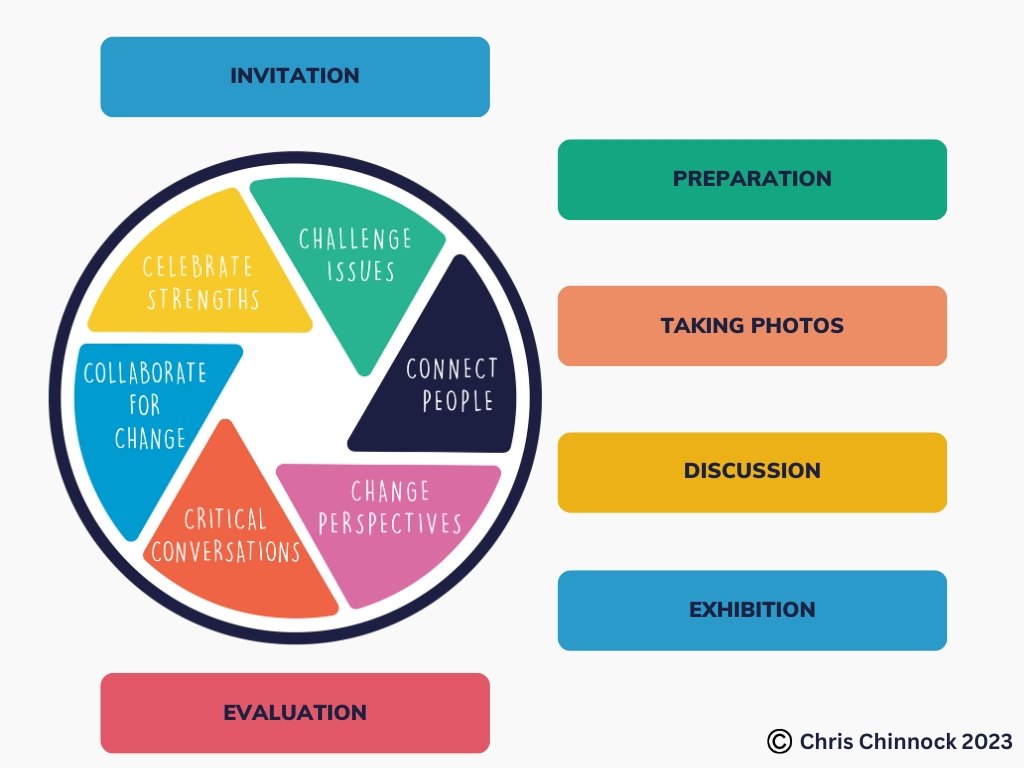Creating the Conditions for Photovoice
I always say that one of the things I love about photovoice is that it’s never the same twice, every group of people is different and the journey we go on is unique to that particular moment in time HOWEVER there are some important elements that I keep in mind to ensure a project can fulfil its potential.
My approach to photovoice is a little different to the traditional methods which are rooted in social research and academic study. I come at this from a community development perspective, I’m interested in the possibilities that photography brings to the way in which people connect and communicate around the things that are important to them.
I want to share my learning on the steps I take to create the conditions for a successful photovoice project. I’ve facilitated Photovoice projects in a range of different settings and I love how this approach is flexible enough to work with any audience. Whether it’s people in a professional context working inside inside organisations or a community setting.
While traditional social research and academic photovoice share a common foundation with community based photovoice practice there are notable differences in their objectives, approaches, and outcomes. Traditional research often focuses on generating new knowledge or validating existing theories, whereas community-driven photovoice prioritises empowerment, advocacy, and social change.
In academic settings, photovoice may be primarily conducted by researchers who guide the process, analyze the data, and disseminate the findings. Conversely, in community development contexts, photovoice encourages community members to take the lead, to drive change and shape their own narratives.
Academic photovoice studies may employ rigorous sampling techniques and research methodologies. In community-based photovoice, the emphasis is on capturing the subjective experiences of participants, embracing their perspectives, and generating narratives that mean something to them and often resonate with a wider audience.
It’s not an either / or situation and I’m certainly not setting these different applications of Photovoice in competition with each other. Photovoice is a valid way of working in both contexts. However I noticed that the majority of the literature surrounding photovoice was written (perhaps understandably) from the academic perspective.
I wanted to make my own small contribution to the community development side of the story by sharing what I’ve found to be essential in supporting my own practice using this wonderful methodology. I’ve mentioned that every project is different and so my approach to delivering sessions is always guided by the specific requirements of each group.
So here’s my hands on, super practical approach to ensuring the best outcome for everyone involved in a photovoice project - these are purely from my own experience and are offered here as suggestions for you to think about in your own practice, I am always leaning into my background in Asset Based Community Development (ABCD) which informs the way I look at the world!
Without further ado, here are the 6 elements that I try to frame every photovoice project with:
Invitation - working at the invitation of host partners and of the people taking part is key. Participation cannot be mandated.
Preparation - familiarise ourselves with the approach, the equipment and thinking about how images can tell stories.
Taking Photos - in and outside of the sessions, can also be old photos, found images or drawings too
Discussion - sharing stories and experiences with each other through images, noticing any patterns that emerge
Exhibtion - inviting others to come and see, connect and share
Evaluation - stepping outside of the process and reflecting on the wider impact of those taking part, audiences and partners involved.
This isn’t a linear process per se, it can be fluid and flexible which is one of it’s natural strengths, however I think it does start with invitation. Without this you are always going against the grain of relationships and trust in a situaion so it’s the one I tend to start with!
I’ll often ask ‘where is the energy coming from for this project’ and ‘where are people already naturally connecting around the subject / topic at hand’ I think of these as important elements to pay attention to that a photovoice project can sit within.
I hope that you’ve found this useful and/or interesting!
_ _ _ _ _ _ _ _ _ _ _ _ _ _ _ _ _ _ _ _ _ _ _ _ _ _ _ _ _ _ _ _ _ _ _ _ _ _ _ _ _ _ _
I am very keen to grow the conversation with fellow travellers, practitioners and folks who are interested in photovoice, community development and the intersection of art and community - if that sounds like you’re cup of tea too then I’d love for you to check out the Our Creative Connection Podcast HERE you can also find it on Apple Podcasts, Spotify and YouTube if you follow the links below!



